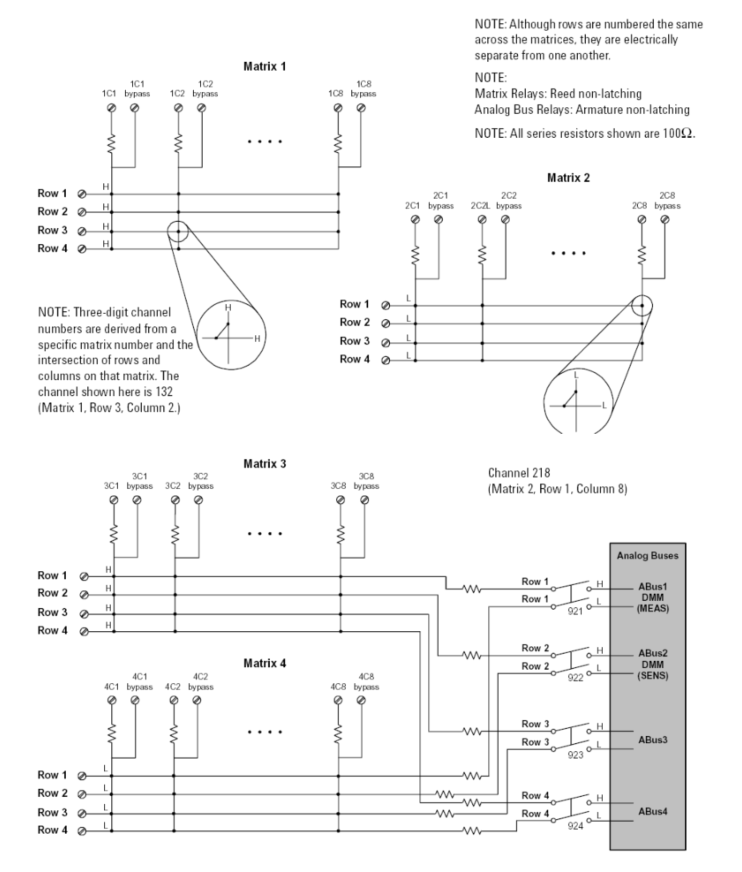
You can configure the 34933A dual/quad 4x8 reed matrix module for differential (2-wire) mode or single- ended (1-wire) mode. The 34933A module contains 100 Ω in- rush resistors that are used to protect the reed relays from reactive loads. If you have applications where in- rush resistors interfere with measurements, connections are provided on the terminal blocks for you to bypass the in- rush resistors that are located on the columns (see the simplified schematics below). However, if you choose to bypass the in- rush resistors, the life of the reed relays that you bypass may be degraded.
Using the Module Wiring Mode tab in the Factory Reset for 34980A dialog box, you can set module configuration to 2-wire, 40-channel (differential) mode or 1-wire, 80-channel (single-ended) mode. Whenever you change the wiring mode, the software must reboot the 34980A for the new configuration to take effect. To physically configure the module wiring mode, you must use the correct terminal block, or a compatible standard or custom cable. Refer to the Agilent 34980A User's Manual for more information including terminal block wiring and safety information.
In 2-wire mode, the 34933A module contains two matrices, each with 32, 2-wire crosspoint non- latching reed relays organized in a 4- row by 8- column configuration. Every row and column are made up of two wires each, a high (H) and a low (L). Each crosspoint relay has a unique channel number representing the row and column that intersect to create the crosspoint. For example, channel 308 represents the crosspoint connection between row 3 and column 08 (all columns consisting of two digits; in this case the digits are 08). See the Factory Reset for 34980A
You can connect any combination of inputs and outputs at the same time. However, only Matrix 2 in 2-wire mode of this module connects to the Analog Buses. By closing channels 921 and 922 you can connect rows 5 and 6 respectively to the internal DMM of the 34980A mainframe for voltage and resistance measurements. In 2-wire mode, you can close no more than 20 channels simultaneously due to power dissipation. However, note that Analog Bus relays count half as much as channel relays in that total. For example, with one Analog Bus relay closed, you can close up to a maximum of 19 channel relays. If you try to close more than the allowed number of channels, you will receive an error message.
In 1-wire mode, the 34933A module contains four matrices (1 through 4), each with 32, 1-wire crosspoint non- latching reed relays organized in a 4- row by 8- column configuration. Every row and column has one wire each. Each crosspoint relay has a unique channel number representing the matrix, and the single-wire row and column that intersect to make the crosspoint. For example, channel 218 represents Matrix 2, row 1 and column 8. See the Factory Reset for 34980A.
In 1-wire mode, you can close no more than 40 channels simultaneously due to power dissipation. For example, with one Analog Bus relay closed you can close up to a maximum of 39 channel relays. If you try to close more than the allowed number of channels, you will receive an error message.
You can connect any combination of inputs and outputs at the same time. However, only Matrix 3 and Matrix 4 in 1-wire mode of this module connect to the Analog Buses. By closing channels 921 and 922 you can connect rows 1 and rows 2 respectively to the internal DMM of the 34980A mainframe for voltage and resistance measurements.
You can connect multiple matrix modules externally and/or through the Analog Buses for applications that require large matrices. For information on linking multiple matrix modules, refer to the Agilent 34980A User's Manual.
When the power is off, matrix relays and Analog Bus relays open.
Warning: Refer to the Agilent 34980A User's Manual for more information including terminal block wiring and safety information.

